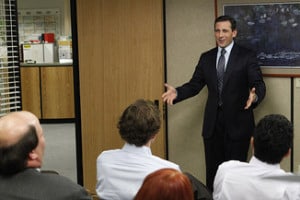You might not think that Michael Scott of NBC’s The Office has much to teach you about facilitating a meeting. But I disagree! If you’ll take a closer look with me, you’ll discover that Michael does just about as much right as he does wrong. In both respects, he’s a worthy guide to a business analyst looking to improve their meeting skills.
3 Things Michael Does Right

#1 – Everyone in the conference room! Yep, it’s annoying, but Michael gets everyone in the room at the same time. Meetings are most efficient when everyone who needs to be there shows up – on time and engaged for the duration of the discussion. In fact, remember the time when Pam tries to avoid a discussion by faking car trouble? Michael stops the meeting until she comes back. Although it can seem really inefficient in the short-term to stop or cancel a meeting when all the key stakeholders aren’t engaged, doing so can increase productivity over the long haul.
#2 – Invites dialog. In a meeting with Michael, there’s almost always that uncomfortable point when he calls someone out. While I don’t condone Michael’s habit of bringing up personal and confidential information in a group setting, often as BAs we need to surface information a stakeholder has shared with us to get the discussion going or make sure all relevant information is out on the table.
#3 – Uses visuals. Remember the episodes when Michael hangs up pictures of famous people, draws out the pyramid scheme, or plays a video of his participation in a game show as a child? In all cases, the truth comes out via visual representations, even if it’s not the truth Michael was hoping for.
As BAs, we can draw on whiteboards, prepare formal or informal models, and bring in scenarios to help surface the reality underneath all the talk. So often, the success of a meeting is highly dependent not so much on what happens in the meeting, but what deliverables we prepare for the meeting.
(By the way, if any of this sounds like something you’d like support bringing to your organization, I’m piloting an Essential Meeting Skills virtual course. It starts August 15 and includes my step-by-step process for facilitating a working meeting, the opportunity to listen in on expert meeting sessions, and 1-1 instructor support as you apply new meeting techniques in your work setting.)
3 Things Michael Does Wrong
#1 – Lack of a Clear Agenda. Most of Michael’s meetings are impromptu and unplanned. Even those that are scheduled in advance don’t seem to follow a clear agenda. Most often, it appears as if Michael is just winging it, perhaps with one or two tricks up his sleeve – tricks that rarely turn out like he expects.
I can sympathize. It’s nearly impossible to put together an agenda that will hold up to a working meeting, which means real work gets done and unknowns get explored. There is always something unexpected that crops up and a savvy BA knows how to re-arrange the agenda on-the-fly to achieve the ultimate goal of the meeting. They also know that a sensible agenda organized to achieve a clear purpose is a powerful guidepost.
#2 – Creates a Stage. Have you ever noticed the most common configuration of the conference room? All the staff are sitting in rows with Michael up front running or being the show. You don’t need to configure your conference room as a theater to face this problem. If the same person always sit at the head of the table or behind the desk in their office, they are positioned as a presenter and your collaborative meeting can quickly become more of a show. This type of meeting can be useful in a small number of situations, but it shouldn’t be the primary type of meeting a BA facilitates.
#3 – Shuts People Down. Sure Michael invites response and draws people out, but he’s almost always looking for a specific answer. When he gets an answer he does not expect, he discredits the information (or worse, the person) or turns it into a joke. This is not a way to build trust with your stakeholders.
It’s easier than you think to form assumptions about the answers you expect and challenge a stakeholder when they bring up conflicting information. And while you might not be overtly dismissive, this communication pattern can send a signal that you are not actively open to accepting new information. I’ve done this more times than I’d like to admit, most often when I’m trying to elicit and analyze requirements in the same meeting.
If you are looking to improve your meeting facilitation skills, I hope you’ll let Michael Scott be your guide. Take his best qualities and by all means avoid his mistakes.
>>Looking for More Support?

Click here to learn more about the Effective Conversations Template Collection
